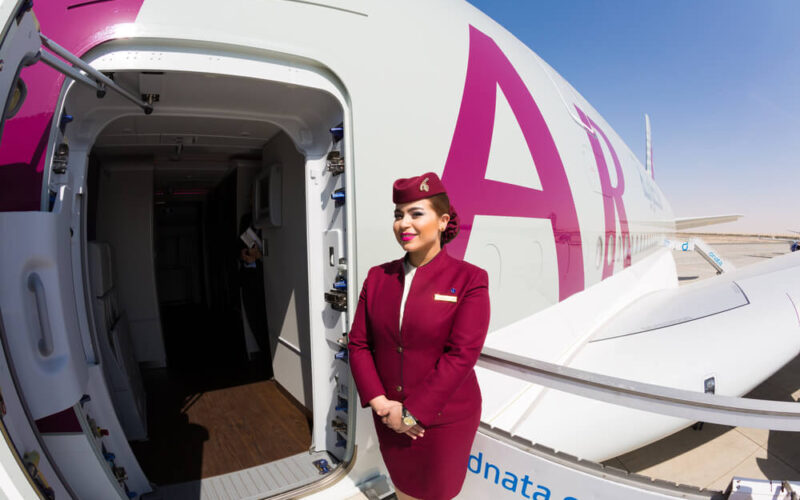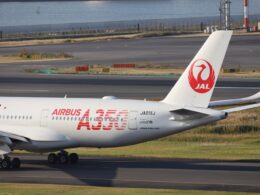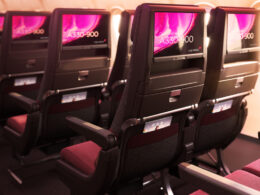To read Part 1 of the in-depth look of the current situation of Qatar Airways, please read the article here:
It is clear that one way or another, the Qatari aviation industry, including its airline and the main airport in Doha, is not looking to sit in one place. With a massive backlog of 300 aircraft for Qatar Airways, including options, and a plan to expand the capacity of Hamad International Airport (DOH) to facilitate 60 million passengers per year by 2022, the country wants to become a powerhouse in the aviation industry.
Current geopolitical events, namely the Gulf country blockade of Qatar, are hindering the aforementioned growth. However, seemingly, the problems do not end there.
With a massive gap between passenger traffic at Hamad International and tourists that actually visit the country and a confusing fleet of various current and incoming aircraft, where does the carrier go next?
Blockade losses
One of the most crucial goals for Qatar and its flag carrier is to restore economic relations between the state and its neighbors. Without getting into the nitty-gritty of economic impact on the country as a whole, for Qatar Airways, the blockade meant losses of some of its most mature and high-demand routes.
For example, in May 2015, the Doha-based airline announced a special shuttle service between Hamad International (DOH) and Dubai’s two airports, Dubai International (DXB) and Al Maktoum International Airport (DWC), with the goal to reduce travel time between the two cities and to increase convenience for passengers. The shuttle ran 18 times a day, with 14 daily flights to DXB and four to DWC.
Furthermore, on July 16, 2015, Emirates announced that for the first time ever, a scheduled Airbus A380 flight landed in Doha. According to the press release, the double-decker was at full capacity.
“In its first seven months of operations, Emirates has carried over 430,000 passengers to and from Doha. Emirates serves Doha with seven daily services.”
But Dubai is not the only mature route that Qatar Airways lost after the blockade started in June 2017. The Centre for Aviation (CAPA) highlights that throughout a six-day period between April 24 and April 30, 2017, the largest routes by capacity on the airline’s network also included flights between Doha and King Abdulaziz International Airport (JED) and King Fahd International Airport (DMM) both in Saudi Arabia as well as Bahrain International Airport (BAH) in Bahrain. Thus, with flights to Dubai (DXB), out of the 10 largest routes by capacity, the airline lost four of them.
Replacement routes
Coming up with replacement connections to other than Gulf countries is no easy task, especially considering the unique situation of the country. Nevertheless, Qatar Airways still tries to elevate demand out of Doha by opening up routes to popular tourist destinations. For example, in preparation for Summer 2020, the airline announced new leisure routes to leisure destinations on December 16, 2019, including Santorini, Greece, and Dubrovnik, Croatia. Previously, the airline inaugurated routes to other holiday destinations such as Langkawi, Malaysia, in 2019.
At the same time, the state-owned carrier tries to position Doha as a connecting hub, transferring passengers from developing or underserved airports. One example could be Cardiff Airport (CWL) in Wales, an airport that saw 1.5 million passengers in 2018. Qatar Airways operates flights to the Welsh airport with a Boeing 787 Dreamliner. When the first flight touched down, the then-Secretary of State for Wales, Alun Cairns, noted that the direct connection “is culmination of months of Government activity in public and behind the scenes,” possibly hinting at government subsidies of the route between the Welsh capital and Doha. The Gulf country is “the UK’s third largest export market in the Middle East and accounts for £35 billion of existing investment,” Cairns added.
While direct connections definitely bring economic benefits, as one International Air Transport Association (IATA) study concluded, for Qatar Airways, Cardiff is used as a starting point for connections eastwards from Doha. Indirectly, the airline’s CEO, Akbar Al Baker, pretty much confirmed it when the first Qatar Airways aircraft landed in Wales on May 1, 2018:
“We are delighted to welcome Cardiff into our route network, and to be able to provide the Welsh people with a new gateway to the world. We look forward to welcoming our new Welsh passengers on board and to connecting them to Doha and many points beyond.”
Cardiff is not the only airport whereupon Qatar Airways attempts to feed its Doha hub. One more example could be Kyiv Boryspil International Airport (KBP) in Ukraine. The airport’s only direct connections to destinations in Eastern Asia are to Delhi, India, Bangkok, Thailand, and Sanya, China. Flights to Africa are also very limited, with only Egypt present on the map. Thus, once again, the Doha-based airline can flex its hub muscles and offer one-stop flights that are otherwise unavailable.
But European airports are not the only targets of this hub-feeding expansion. The recently opened route from Gaborone Sir Seretse Khama International Airport (GBE) in Botswana could also be used as an example. With Qatar Airways’ only competition being Ethiopian Airlines and the now-almost bankrupt South African Airways, the airline can once show off its strength, including the power of its brand, offering one-stop connections to a wide variety of destinations, including connections for passengers that wish to travel to Botswana.
While the hub-and-spoke model slowly fading into the sunset, airports with limited traffic or limited long-haul traffic still rely on hubs to connect them to the outside world. Another advantage of Qatar Airways is the fact that it is the only Gulf carrier within an airline alliance, namely oneworld. Although the relationship between the Qatari company and the rest of the alliance is quite spicy, with Al Baker having threatened to leave oneworld multiple times, it is still an active member and maintains benefits of its membership.
At the end of the day, seemingly, Al Baker summed up the airline’s strategy fairly well, when Qatar Airways announced new destinations for its Summer 2020 schedule on December 16, 2019:
“We are committed to offering our passengers as many seamless one-stop connection choices as possible.”
Yet keeping these passengers inside of Qatar rather than them never leaving the airport is something that the airline, together with its main shareholder, the State of Qatar, is trying to do. Without the aforementioned tourism initiatives explained in Part I of the series, the airline also launched “Qatar Stopover” – a digital promotional campaign and sales platform to promote tourism within the Gulf state. Passengers that transit (minimum transit time of 12 hours) via Doha on outbound or inbound flights can book hotels or various experiences on the airline’s website. The program was launched in May 2017 and Qatar Airways’ website indicates that the offer is valid till December 28, 2020.
Whether the initiative brings tangible results is hard to judge due to the fact that Qatar’s tourism numbers were heavily impacted by the blockade. However, in 2018, tourist numbers from African, Asian (excluding Gulf Cooperation Council and Other Arab nations), European and American countries were on the rise: an increase of 3.3%, 15.5%, 9.2% and 3.4%, respectively. While the increase looks impressive percentage-wise, in the end, only 1.8 million international visitors explored the country, making Qatar one of the least-visited countries in the Middle East, according to World Tourism Organization data.
But the low tourist numbers are only one part of the problem, as Qatar Airways tries to offset its losses.
Losses and fleet decisions
The blockade weighed heavily on the airline. It tried to offset the route losses by increasing capacity in FY2019, as evident by the yearly Available Seat Kilometer (ASK) increase of 13.4% (from 203,650 in FY2018 to 231,094). However, the increase in capacity barely translated into an increase in passenger numbers: they were up by 1.1% (from 29.1 million to 29.4 million). The total operating expenses went up by 18% – from $11.5 billion (QAR42.2 billion) to $13.7 (QAR50 billion), with fuel accounting for 36.2% of total expenses.
To achieve its goal to break-even in two years’ time, the airline has some cost-cutting measures to do. Of course, with the end of the blockade allowing the airline being able to use the most efficient routes would help reduce the biggest headache in Qatar Airways’ balance sheets, but the complexity and questionable efficiency of the fleet is also a potential pain in the bottom.
With its short-haul fleet of Airbus A320 family aircraft averaging an age of 13.4 years and its A330 aircraft also showing their age (excluding the A330F that are on average 4.6 years old), replacing older aircraft is one way to reduce the fuel bill. But a big part of the efficiency problem is the quad-engine Airbus A380 that consumes a fair amount of Kerosene.
Qatar Airways is on its way to renew its fleet. Yet various issues that are outside of the carrier’s control are negatively impacting the renewal process. For example, the carrier will only receive four Airbus A321neo aircraft in 2020, a number which was supposed to be higher, according to Al Baker. In total, Qatar Airways has 50 A321neo jets on order.
Boeing’s ongoing issues with the 777X is also having a negative impact, as they were supposed to replace the-still fairly young Triple Seven jets (some of the oldest 777s are just north of being 12 years old, while some entered service in 2018). The airline’s CEO noted that they will not retire any of their older Boeing 777 aircraft until the 777X enters the fleet, Gulf Times reports.
Al Baker has also publicly slammed Rolls-Royce over the Trent XWB that powers the A350, stating that the British engine maker is failing to meet performance, timeline and reliability requirements.
Summing up, Qatar Airways’ situation is a polarizing subject. On one hand, the airline wants to become a global powerhouse and in some ways, it is. It has one of the biggest networks of destinations in the region, with a lot of airports otherwise unavailable to those that wish to travel to the Middle East. The airline tries hard to promote its brand in both mature and developing markets via sponsorships. In addition, it is aggressively investing in other airlines and even airports, as Qatar Airways aims to make its hub, Doha Hamad International Airport (DOH), the main connecting point between Europe, Africa and Asia.
On the other hand, the main profiteer of the success of the airline is the State of Qatar, which is also the main shareholder of Qatar Airways. Arguably, though, with over 30 million passengers per year in DOH and the country never seeing over 3 million annual international visitors over the last five years, the question stands how much value does the airline truly bring to the country? Nevertheless, both the country and the company are trying to change that fact with various promotional campaigns, which, however, require time to deliver results.













